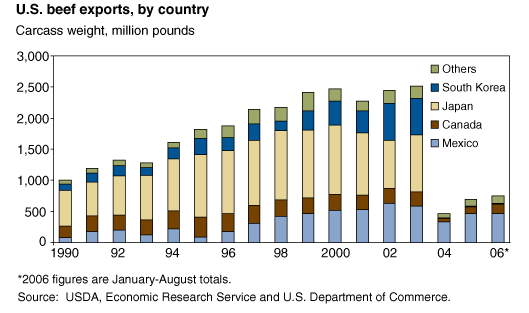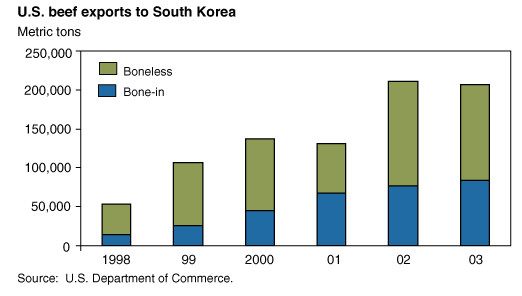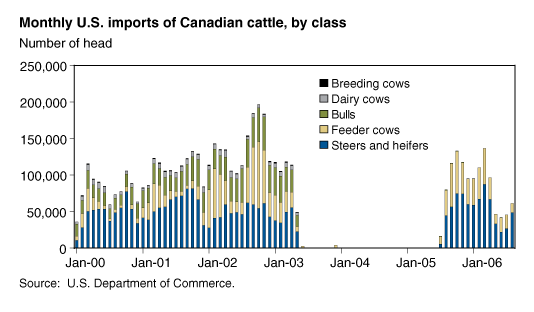



Livestock and Meat Trade: A Look at the Effects of BSE
By Monte Vandeveer, Amber Waves, Economic Research Service, USDA - U.S. imports and exports of livestock and meat products are worth several billion dollars each year.
BSE Discovery Leads to Trade Bans and Precipitous Fall in U.S. Beef Exports
This trade has been noticeably affected by disease-related issues in the last few years. ERS recently released a data set that provides greater detail on U.S. livestock and meat trade. This data set contains monthly and annual data for the past 1-2 years for imports and exports of live cattle and hogs, beef and veal, lamb and mutton, pork, broiler meat, turkey meat, and shell eggs, as well as historical data on trade in these products.
Breakdowns by major trading countries are included. It also includes details on product categories for traded livestock and meat products well beyond the aggregate measures often reported. These details are used to illustrate perhaps the best-known case of disrupted trade in U.S. meat and livestock, that of bovine spongiform encephalopathy (BSE), over the past 3 years.
By the time a dairy cow in Washington State (imported from Canada) was found to have BSE in late December 2003, U.S. beef exports had risen steadily for more than two decades, reaching 2.5 billion pounds in 2003, or roughly 9 percent of U.S. domestic beef production. Four countries—Japan, Mexico, South Korea, and Canada—accounted for more than 90 percent of U.S. beef export volume through 2003. Discovery of BSE led to bans on U.S. beef from nearly all U.S. trading partners. Canada and Mexico quickly resumed their purchases after the BSE case, but Japan and South Korea were much slower to reopen their markets. As a result, U.S. beef exports fell by over 80 percent in 2004 and still remain well below their earlier levels.
Japan and South Korea have both agreed to resume importing U.S. beef but with certain restrictions on which products may enter. Japan currently accepts beef only from animals under 21 months of age and prohibits “specified risk materials” (SRMs, or parts such as the brain and spinal cord, which are known to contain the BSE infective agent). South Korea also prohibits SRMs but accepts beef from animals up to 30 months of age. However, South Korea indicated it would accept only boneless products, and the first three U.S. beef shipments there were rejected for containing bone fragments. Bone-in products were an important share of the Korean market before 2003 and were growing in absolute terms.


BSE Changes the Structure of U.S.-Canada Trade
The discovery of a BSE case in Canada in May 2003 also significantly changed U.S. cattle and beef trade with that country. Before 2003, Canada’s cattle exports amounted to 25-40 percent of its domestic total slaughter, and it exported over 40 percent of its beef production, with both cattle and beef exports going primarily to the United States. The U.S. border reopened to Canadian beef in September 2003, but Canadian cattle were not allowed in until July 2005, leading to rapid growth in the Canadian cattle inventory during this interim. When the border reopened, imports of Canadian cattle began to displace imports of Canadian beef.
Currently, the U.S. allows imports only of animals younger than 30 months destined for immediate slaughter or for feedlots and then slaughter. But before May 2003, cows and bulls for slaughter (primarily cull animals from the breeding herd) were also an important class of imports. USDA is now considering a rule change to allow imports of older animals, although another Canadian BSE case involving a cow born well after Canada’s 1997 feed ban had earlier caused USDA to withdraw the proposed rule temporarily while it reviewed its risk assessments.




